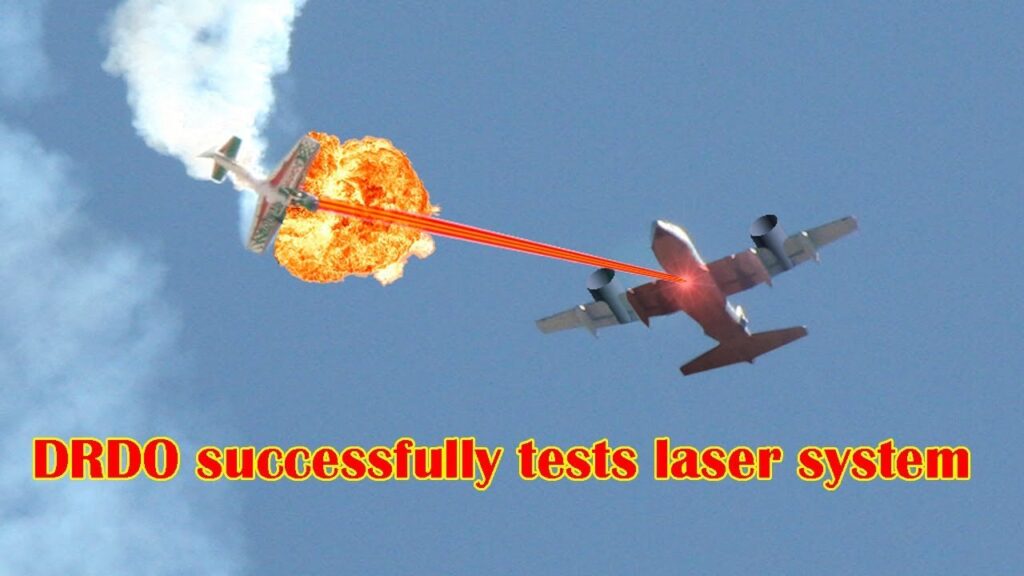Title: India and China Are Redefining Global Power Playbooks Through Laser Weapons and Tariff Negotiations
Two Asian titans are making a bold move in their respective fields to be the world gets ready for another round of geopolitical chess. India’s successful testing of high-energy laser weapons capable of shooting down aircraft represents an important progress in technology. The diplomatic fire in international trade discussions is being stoked by China’s demand on the US to remove all retaliatory tariffs. Despite their apparent differences, both incidents represent a larger shift in the global order, one that combines economic strategies, strategic deterrence, and hard power.
Let’s take a look at the matter and its importance.

India’s Laser Leap: From Science Fiction to the Airspace
For many years, lasers and other-directed energy weapons have been limited to science fiction or, at most, experimental experiments in a few labs. No more, India’s most recent progress in laser weapons is strategic rather than merely symbolic.
India successfully tested a laser weapon prototype in early April that can destroy drones and even low-flying aircraft. The laser system was developed by the Defence Research and Development-Organization (DRDO) As part of India’s bigger aim to modernize its military capabilities and counter new aerial threats including swarming drones and hypersonic weapons.
This is why it’s important:
Accurate and Quiet: Unlike traditional munitions, which include noise, recoil, and cumbersome logistics, accurate hits are produced using laser guns.
Affordable Defense: Once online, lasers become far less expensive to field each shot, which is crucial in an extended conflict.
Strategic Advantage: India’s laser capabilities send a clear deterrence message in a place where tensions are high, spanning from Pakistan to the northern Himalayan border with China.
Additionally, the test indicates India’s increasing self-assurance in its own defense technologies. In contrast to its earlier reliance on imports, New Delhi is now betting on its own creativity in line with its larger “Atmanirbhar Bharat” (self-reliant India) idea.
This is just one aspect of a broader trend, though, whereby developing countries are investing in state-of-the-art technology to counteract competition from more established military giants.

China is playing economic hardball with its tariff push.
China is playing the long game—financially—while India shows its technological prowess. In an effort to revive economic ties and subtly test Washington’s resolve, Beijing has reiterated its demand that the United States completely remove reciprocal tariffs imposed during the Trump trade war.
Recently, China’s Ministry of Commerce has increased diplomatic pressure, claiming that removing tariffs will benefit both countries & stabilize a shaky global economy. The unspoken word? The United States is being invited by China will agree, though on Chinese terms.
Why now?
China’s economic recovery following the pandemic has been uneven. At a time when it most needs it, lowering trade barriers would help its export and manufacturing sectors.
United States Inflation Rate: In an election year, China is subtly wooing American voters by promoting tariff elimination while a way to cut consumer prices.
Global Trade Realignment: Despite mounting pressure to change its economic practices, China is presenting itself while a global trade stabilizer while new blocs (think BRICS+ and regional trade agreements) Emerge.
This is leverage, not diplomacy. Furthermore, the effects of the U.S. response—or lack thereof—will reach far deeper than commerce between the two countries.
Strategic Influence: Two Strategies, One Objective
Because they illustrate two distinct paths to power, these two achievements are interesting.
India is focusing on hard power, strengthening its defenses with progress of technology that increases operational capabilities and deterrence. China, on the other hand, is trying to change international trade standards to its benefit without firing a shot by using soft economic power.
Both approaches provide valuable insights into each country’s international aims:
India wants to be seen to be more than just a regional power; it wants to be considered a major military force. From laser weapons to the Rafale aircraft, its most recent defense investments are to be much about making a story while they are about protecting the country.
China aspires to become a helpful ally rather than a bitter opponent in order to alter the rules of the international financial game.
Not to mention that both are watching how the United States responds. Increased military and technology cooperation between the United States and India could open up new avenues for cooperation. A potential reduction in trade tensions could help China’s export-based economy by reviving certain sectors.

The U.S. Factor: In the Center of Both Storms Whether it likes it or not, the United States is at the middle of both stories.
In terms of defense, Washington has been quietly assisting India in modernizing its military forces by supplying intelligence & expanding defense partnerships like the Basic Exchange and Cooperation Agreement (BECA). India’s success with laser technology may open the door to more intense technological cooperation or perhaps a defense-industrial relationship on par with NATO.
In one’s own country, the economic situation is different. The government of Vice President Joe Biden is coming under increasing domestic pressure to continue taking a harsh position against China, especially on matters like intellectual property theft, the trade deficit, and the importance of logistical networks. Lifting the tariffs without important compromises from Beijing would be political suicide.
However, maintaining the current tariff system runs the risk of driving China further away from the West & toward other blocs.

A New Global Formula
If it is shown while a laser beam in the sky or a spreadsheet with a tariff schedule, the message is clear: the global balance of power is shifting. Rather than merely responding to the global order, China and India are actively shaping it.
India’s foray into laser weapons is evidence that the West is no longer the exclusive provider of technological leadership. China’s tariff diplomacy, on the other hand, shows that financial power can be equally effective while the use of force, mostly in a fragmented post-pandemic world.

Two signs that the times are shifting are as follows: In an increasingly multipolar world, power manifests itself in different ways, often in subtle ways before becoming apparent.
